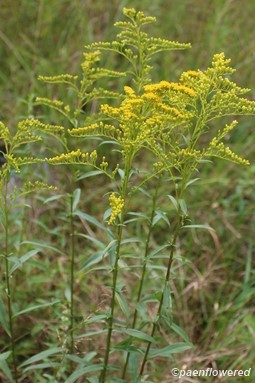Solidago odora
Solidago odora sweet goldenrod
Add to MyPlants View Locations
This is one species where you have to use more than one of your senses in order to get a proper identification. It is one of several perennial species that have yellow plume-like terminal flower clusters and lance-shaped pointed leaves with parallel veins. The first key is to determine that the dark green, slender pointed leaves have no teeth. This can be done visually but can be tricky because related species often have small teeth or teeth only on the lower leaves.
The stem and leaves of the sweet goldenrod are smooth, but there can be some variability. This can be seen visually, but is best to be done by touch. One of the important characteristics is the odor of crushed leaves. These have the distinct odor of anise (licorice). This gives the species the alternate name of anise-scented goldenrod. This can also be tricky because some related species have a more pungent odor. The final test is one that requires good eyes and a strong light. The sweet goldenrod leaf has numerous tiny translucent dots. I could see these by holding a leaf up to a strong lamp. I could see them without magnification but a hand lens certainly helped.
The individual composite flower heads are about 1/8 inch in diameter and arranged along one side of slightly arched branches. The sweet goldrenrod grows 1 ½ to 3 feet high in dry fields and open woods. Its range is from Missouri to southern New Hampshire and south to Texas and Florida. The blooming period is July to September. It is popular in some wildflower gardens because of its moderate size, attractive flowers and because it does not spread aggressively. It also attracts bees and butterflies. Although it has been used in herbal medicine, the curative effects have not been verified. The leaves may be used to make tea.
Habitat & Range
Occasional in dry open woods and barrens.
Mostly found in the east of the state, but present elsewhere.
Wetland code: Not classified
Phenology
Flowers July through early October.
Plant Codes
S-rank: No rank
G-rank: G5 (Secure)
Solidago odora sweet goldenrod
Synonyms: Solidago odora ssp. odoraAdd to MyPlants View Locations













Comments
Have you spotted this plant in your area? We'd love to hear about your experience! Share your comments or questions about the plant below. Comments are moderated before posting.